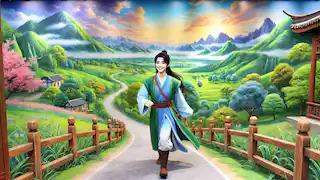Once upon a time, in the Eastern Jin Dynasty, there was a beautiful young woman named Zhu Yingtai, who belonged to a wealthy family in Shangyu, Zhejiang. Although it was uncommon for women to receive education during that period, Yingtai had a strong desire to learn and broaden her knowledge. She repeatedly requested her father to allow her to attend school disguised as a man. Eventually, her father consented, and Yingtai set off for Hangzhou to pursue her studies.
As she embarked on her journey, Yingtai couldn't contain her excitement. The thrill of learning and the anticipation of new experiences filled her heart with joy. Her mind raced with thoughts of the knowledge she would gain, the books she would read, and the wisdom she would acquire. The journey itself was a significant undertaking, filled with sights and sounds that were new to her. She marveled at the landscapes, the bustling towns, and the diversity of people she encountered along the way.
Upon arriving in Hangzhou, Yingtai quickly befriended a fellow student named Liang Shanbo. They became inseparable, studying together, sharing their thoughts, and forming a deep bond. Shanbo, a diligent and kind-hearted young man, was drawn to Yingtai's intelligence and charm, unaware of her true identity. For three years, Yingtai managed to keep her true identity hidden, and during this time, her feelings for Shanbo grew into love.
Their bond was one of mutual respect and admiration. They spent countless hours discussing literature, philosophy, and the arts. Shanbo often shared his dreams and aspirations with Yingtai, and she, in turn, encouraged and supported him. Their friendship was pure and profound, each finding in the other a kindred spirit.
One spring day, Yingtai received a letter from her father, urging her to return home. With a heavy heart, she prepared to bid farewell to her beloved friend. Before leaving, she hinted at her true identity by offering Shanbo a jade pendant as a token of her affection. She also promised to arrange a meeting between Shanbo and her "sister" once she returned home.
Shanbo, however, remained oblivious to Yingtai's true feelings and her disguise. He accepted the pendant, puzzled by her words, but hopeful of meeting her "sister." After Yingtai departed, Shanbo felt a void in his life, a sense of loss that he couldn't quite understand.
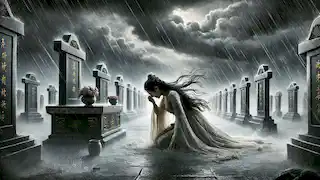
Yingtai's journey home was bittersweet. She cherished the memories of her time with Shanbo but dreaded the reality awaiting her. Upon her return, her father informed her that she had been betrothed to Ma Wencai, a wealthy man from a prominent family. Yingtai was devastated. She had hoped to marry Shanbo, the man she truly loved.
Unable to contain her sorrow, Yingtai wrote a letter to Shanbo, confessing her true identity and her love for him. When Shanbo received the letter, he was both shocked and elated. He immediately set out for Shangyu to declare his love for Yingtai and seek her father's approval.
Upon arriving in Shangyu, Shanbo was confronted with the harsh reality of Yingtai's arranged marriage. Despite his best efforts, Yingtai's father refused to break the engagement. Heartbroken, Shanbo fell gravely ill and died soon after. His death plunged Yingtai into deep despair, but she remained resolute in her love for him.
The day of Yingtai's wedding arrived, and she was led in a grand procession to the Ma family estate. As the procession passed by Shanbo's grave, a fierce storm suddenly erupted. The wind howled, the rain poured, and the sky turned dark. Yingtai, overcome with grief, broke free from the procession and threw herself upon Shanbo's grave, weeping bitterly.
Miraculously, the grave opened up, and Yingtai disappeared into it. Moments later, two beautiful butterflies emerged from the grave, fluttering around each other in a graceful dance. The storm subsided, and the sky cleared, leaving the onlookers in awe of the transformation.
The butterflies, believed to be the spirits of Yingtai and Shanbo, flew away together, never to be separated again. Their love story became a legend, symbolizing eternal love and devotion.
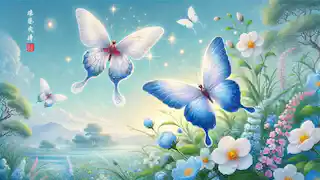
As the years passed, the tale of the Butterfly Lovers spread far and wide, inspiring countless generations with its poignant message. The story was retold in songs, poems, and plays, each version capturing the essence of Yingtai and Shanbo's undying love.
In modern times, the story of the Butterfly Lovers continues to resonate with people around the world. It serves as a reminder that true love knows no boundaries and that the spirit of love can transcend even death.
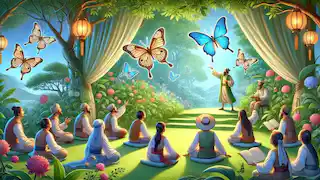
In the tranquil town of Shangyu, a beautiful garden was created in memory of the Butterfly Lovers. The garden, filled with vibrant flowers and fluttering butterflies, became a place of pilgrimage for lovers and romantics alike. People would come from near and far to witness the enchanting beauty of the garden and to honor the enduring love of Yingtai and Shanbo.
As the garden became more renowned, it drew scholars, poets, and artists who found inspiration in its serene beauty. They would sit for hours, reflecting on the story of Yingtai and Shanbo, and create works that celebrated their love. The garden's beauty was a living testament to the power of love and its ability to endure beyond the confines of mortal life.
The story of Yingtai and Shanbo also influenced cultural practices. It became customary for young lovers to visit the garden and pledge their love to each other. Many believed that the spirit of the Butterfly Lovers would bless their union and ensure their love endured through life's challenges. Weddings and engagements began to take place in the garden, each ceremony adding another layer to the garden's rich history.
As time went on, the garden was meticulously maintained by generations of caretakers who viewed their role as a sacred duty. They planted flowers that were known to attract butterflies, creating a vibrant and ever-changing tapestry of colors. Each flower, each butterfly, was seen as a symbol of Yingtai and Shanbo's love, a love that was as beautiful and fleeting as the butterflies themselves.
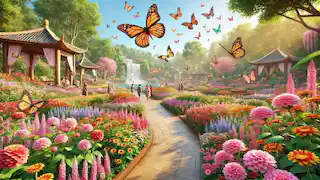
The legend of the Butterfly Lovers also found its way into the educational curriculum. Children in schools would learn about Yingtai and Shanbo, not just as a story, but as a lesson in the power of love, loyalty, and sacrifice. The story was used to teach values such as perseverance, the importance of following one's heart, and the impact of societal norms on individual happiness.
In literature, the tale was analyzed for its themes of gender roles and the constraints placed on individuals by society. Scholars debated the symbolism in the story, the significance of the butterflies, and the transformation of the characters. The story was a rich source of academic exploration, providing insights into the culture and values of the Eastern Jin Dynasty.
In theater, the story of the Butterfly Lovers was adapted into numerous plays and operas. Each performance brought a new interpretation, a fresh perspective on the timeless tale. Audiences were captivated by the emotional depth of the characters and the dramatic unfolding of their love story. The performances were known to evoke tears and applause, leaving a lasting impact on those who witnessed them.
In the realm of visual arts, the story inspired countless paintings, sculptures, and other artworks. Artists depicted key scenes from the story, such as Yingtai's journey to Hangzhou, the moment of revelation at Shanbo's grave, and the transformation into butterflies. These artworks were displayed in galleries and museums, ensuring that the story continued to be shared with future generations.
The influence of the Butterfly Lovers extended beyond China, reaching audiences around the world. The story was translated into numerous languages, each translation bringing the tale to new cultures and communities. The universal themes of love, sacrifice, and transformation resonated with people from diverse backgrounds, making the Butterfly Lovers a global symbol of enduring love.
Today, the story of Yingtai and Shanbo remains as powerful as ever. It is a testament to the enduring nature of love and the human spirit's ability to transcend even the most challenging circumstances. The garden in Shangyu continues to be a place of pilgrimage, drawing those who seek to connect with the profound love story of the Butterfly Lovers.
The butterflies that flutter through the garden are a constant reminder of Yingtai and Shanbo's love. Visitors often pause to watch them, reflecting on their own relationships and the nature of love. The sight of two butterflies dancing together in the air brings comfort and hope, a visual representation of a love that never dies.
In commemorating Yingtai and Shanbo, the garden and the story serve as a reminder that true love is timeless and transcendent. Their story encourages us to cherish our loved ones, to remain true to our hearts, and to believe in the power of love to overcome all obstacles.
The Butterfly Lovers' tale is more than just a story; it is a legacy that continues to inspire and touch the hearts of people everywhere. Whether through literature, art, education, or personal reflection, the story of Yingtai and Shanbo lives on, a beacon of love's enduring power.
I hope this expanded version meets your expectations!
